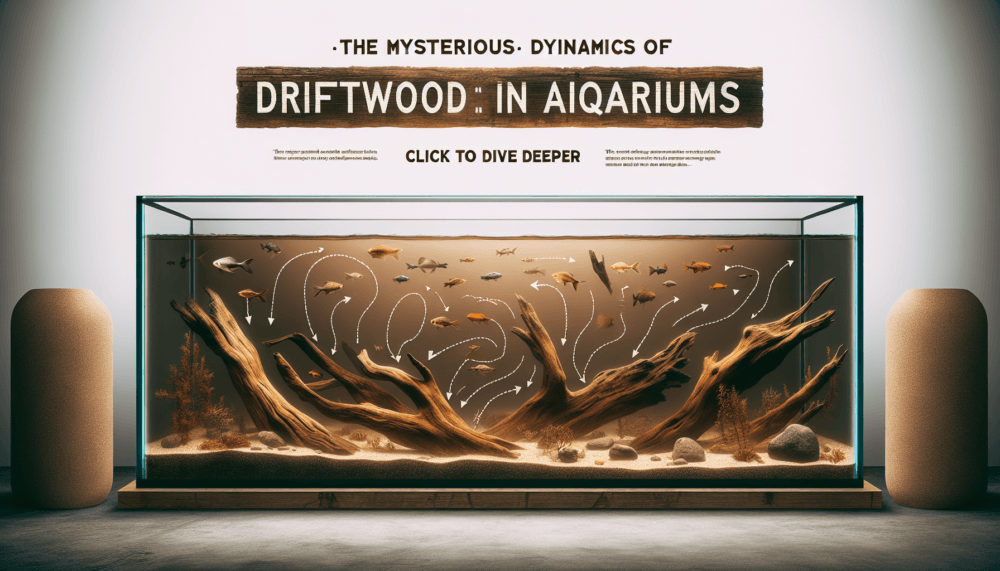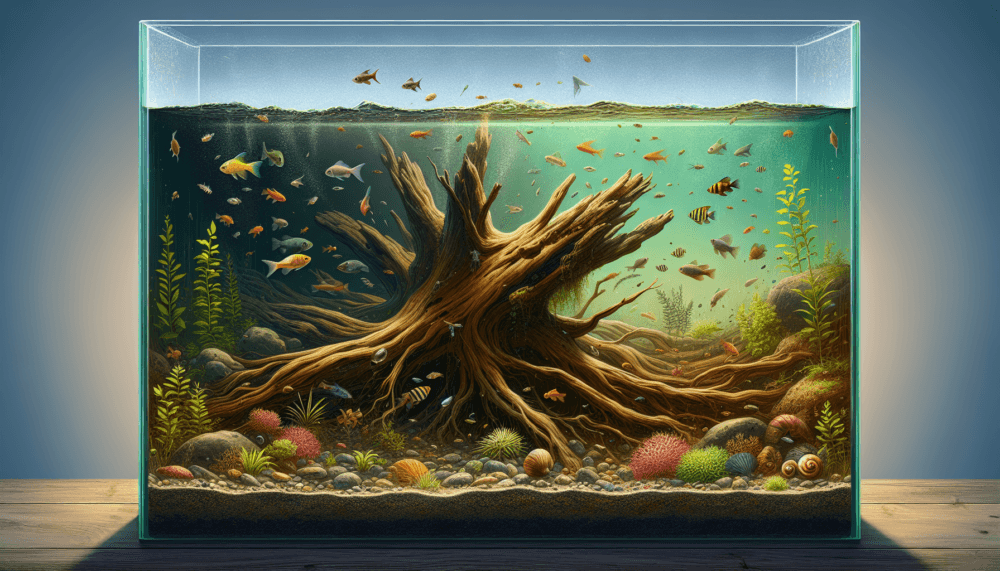Have you ever wondered how long driftwood tannins last in your aquarium? If so, you’re in luck! In this article, we will explore the fascinating world of driftwood tannins and uncover the answer to one burning question: how long do they really stick around? Get ready to dive into this captivating topic and discover the impact of these natural compounds on the aquatic environment.
Overview
Driftwood tannins are a natural component of driftwood that are released into the aquarium water over time. They give the water a brownish or tea-like color and can have various effects on the aquarium environment. Understanding the factors affecting tannin release, the duration of tannin release, and the impact of tannins on the aquarium is crucial for successful aquarium maintenance. In this article, we will explore driftwood tannins in detail and provide tips for managing them effectively.
Definition of driftwood tannins
Driftwood tannins are organic compounds that are extracted from decaying wood and released into the water. They are a mixture of polyphenols and other compounds that give the water a yellow to brown coloration. These tannins can be found naturally in various types of driftwood, such as Malaysian driftwood, spiderwood, and mopani wood.
Importance of driftwood tannins in aquariums
Driftwood tannins play an important role in creating a natural and aesthetically pleasing environment in aquariums. Many fish species, especially those from blackwater habitats, thrive in water with a slight tint caused by tannins. Tannins also provide natural water conditions that simulate the fish’s natural environment, which can promote their overall health and well-being.
Factors Affecting Driftwood Tannin Release
Type of driftwood
The type of driftwood used in the aquarium greatly affects the release of tannins. Different species of wood have different tannin content, and some woods release more tannins than others. For example, Malaysian driftwood is known for its high tannin content and can lead to significant tannin release in the aquarium.
Size of driftwood
The size of the driftwood also plays a role in tannin release. Smaller pieces of driftwood tend to release tannins more quickly compared to larger pieces. A larger surface area allows for more tannins to be released into the water, while smaller pieces may take longer to saturate the surrounding water.
Water chemistry
The chemistry of the aquarium water can influence the rate of tannin release. Water with a low pH and low hardness tends to extract tannins more readily from the wood. Additionally, higher levels of dissolved organic matter and humic substances in the water can also increase tannin release.
Water temperature
The temperature of the aquarium water affects the rate of tannin release. Warmer water tends to speed up the release of tannins, while cooler water slows it down. If you want to control the release of tannins, adjusting the water temperature within the suitable range for your aquarium inhabitants can help manage tannin levels.
Water flow and circulation
The flow and circulation of water in the aquarium also impact tannin release. Increased water flow around the driftwood can facilitate the release and dispersal of tannins, resulting in a quicker saturation of the water. On the other hand, minimal water flow may slow down the release and accumulation of tannins.

Duration of Driftwood Tannin Release
Initial release
When adding driftwood to an aquarium, there is often an initial burst of tannin release. This can cause a sudden change in water color and may be more pronounced with certain types of driftwood. The initial release of tannins can last anywhere from a few days to a few weeks, depending on various factors such as the size and type of driftwood, water chemistry, and temperature.
Temporary discoloration
After the initial release, the water may remain slightly discolored due to residual tannins. This temporary discoloration can persist for several weeks or even months, gradually diminishing over time. Regular water changes and the use of filtration methods can help accelerate the removal of tannins and restore water clarity more quickly.
Long-term tannins
In some cases, tannins may continue to be released by the driftwood over an extended period of time, even after the temporary discoloration has resolved. This is more common with certain types of driftwood that have a higher tannin content. Long-term tannins may require ongoing management and maintenance to keep their levels within acceptable limits.
Impact of Driftwood Tannins on Aquarium
Aesthetics and water clarity
The presence of driftwood tannins can have a significant impact on the aesthetics and water clarity of an aquarium. While some aquarists enjoy the natural, tea-colored appearance that tannins provide, others prefer crystal-clear water. It is important to consider personal preferences and the specific requirements of the aquarium inhabitants when managing tannin levels.
pH and water parameters
Driftwood tannins have the potential to lower the pH of the aquarium water. This can be beneficial for fish species that prefer acidic water conditions, as tannins can help create an environment that closely mimics their natural habitat. However, it is important to regularly monitor the pH levels and make adjustments if necessary to prevent any drastic fluctuations that may be harmful to the fish.
Beneficial properties of tannins
Tannins offer a range of beneficial properties for aquarium inhabitants. They possess natural antibacterial and antifungal properties, which can help support the overall health of the fish and reduce the risk of infections. Tannins can also act as natural water conditioners, promoting the growth of beneficial microorganisms and contributing to the overall balance of the aquarium ecosystem.

Methods to Remove or Reduce Driftwood Tannins
Water changes
Regular water changes are an effective method to reduce tannin levels in the aquarium. By replacing a portion of the aquarium water with fresh, dechlorinated water, you can dilute the tannins and improve water clarity. Depending on the severity of tannin discoloration, more frequent or larger water changes may be necessary.
Activated carbon
Using activated carbon in the aquarium filter can help remove tannins by adsorbing them from the water. Activated carbon acts as a chemical filter, trapping organic compounds such as tannins and other impurities. It is important to replace the activated carbon regularly to maintain its effectiveness in removing tannins.
Chemical media
There are specialized chemical media available on the market designed specifically for removing tannins from aquarium water. These media can be added directly to the filter or placed in a filter media bag within the aquarium. They work by adsorbing tannins and other organic compounds, effectively reducing their concentration in the water.
Boiling or soaking the driftwood
Before adding driftwood to the aquarium, it is recommended to boil or soak it thoroughly to remove excess tannins. Boiling the driftwood for a few hours can help leach out many of the tannins, significantly reducing their release into the aquarium water. Alternatively, soaking the driftwood in a separate container for several days or weeks can also help reduce tannin levels.
Tips for Managing Driftwood Tannins
Choosing driftwood with lower tannin release
If you prefer minimal tannins in your aquarium, it is advisable to choose driftwood with lower tannin content. Research different types of driftwood and select one that is known to have lower tannin release. Spiderwood and manzanita wood are popular choices as they generally have lower tannin content compared to Malaysian driftwood or mopani wood.
Pre-soaking and boiling driftwood
To minimize tannin release, pre-soak or boil the driftwood before adding it to the aquarium. Soaking the driftwood in a separate container for several days or weeks can help saturate the wood and reduce the initial tannin release. Boiling the driftwood for a few hours will further remove excess tannins, ensuring a slower release into the aquarium water.
Ongoing maintenance and monitoring
Regular maintenance and monitoring of tannin levels are essential for managing driftwood tannins. Regular water changes, filter maintenance, and the use of appropriate chemical media can help control tannin concentrations in the water. It is also important to monitor the pH and overall water parameters to ensure they remain stable and within the preferred range for your aquarium inhabitants.
Conclusion
Driftwood tannins are a natural component of driftwood that can have both aesthetic and functional benefits in the aquarium. While they may initially cause water discoloration, the release of tannins can be managed and controlled through various methods. By understanding the factors affecting tannin release and implementing appropriate management strategies, you can enjoy the beauty of driftwood in your aquarium while maintaining optimal water conditions for your fish.